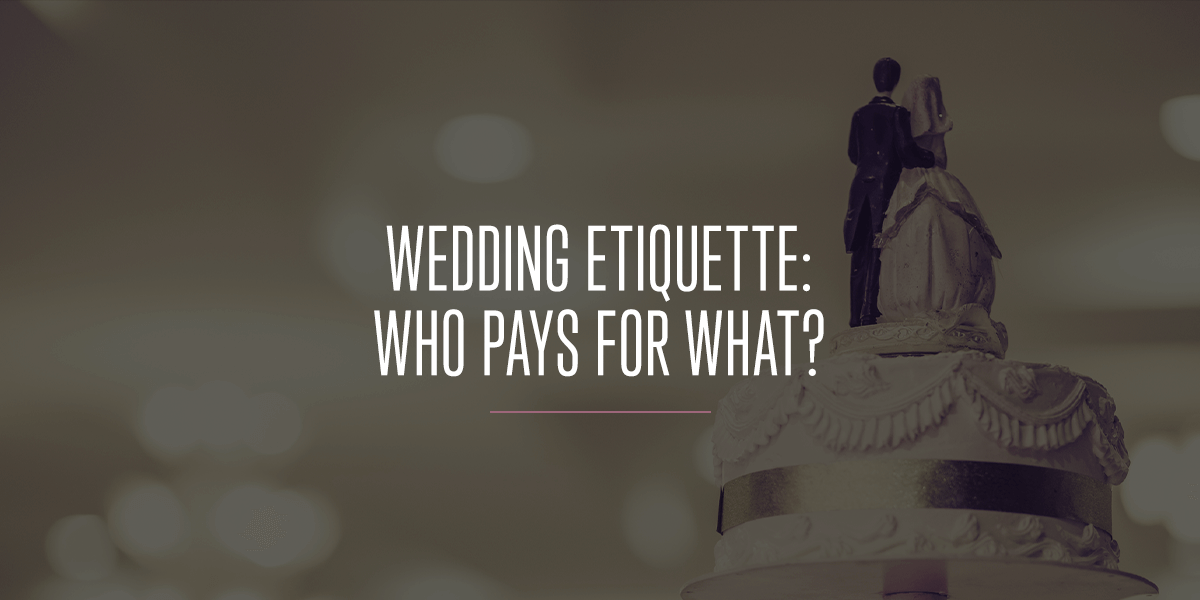
Who pays for the wedding etiquette rules? This question sparks a fascinating exploration of tradition, modern perspectives, and the evolving dynamics of weddings. From historical roots to contemporary practices, we delve into the often-uncomfortable topic of wedding costs, examining how societal norms, cultural influences, and family expectations shape the financial landscape of this significant life event. We’ll uncover the shifting responsibilities of couples, families, and friends in covering wedding expenses.
The traditions surrounding wedding etiquette often intertwine with the financial aspects. This exploration reveals the intricate web of expectations and the potential conflicts that arise when these traditions clash with modern realities. Different cultures have unique customs, and this discussion will illuminate the varied approaches to wedding cost-sharing around the world. Ultimately, this examination aims to help couples navigate the delicate balance between tradition and modern financial considerations.
Defining Wedding Etiquette Rules
Wedding etiquette, a complex tapestry woven from tradition and custom, dictates the acceptable behaviors and expectations surrounding weddings. It’s more than just a set of rules; it reflects societal values, cultural norms, and historical influences, shaping the way couples and guests interact during this significant life event. Understanding wedding etiquette is key to navigating the often intricate dance of celebration and respect.Wedding etiquette is a multifaceted concept, evolving alongside societal norms and reflecting shifting cultural values.
It encompasses a wide range of practices, from the dress code for guests to the appropriate gift-giving customs. Its purpose is to ensure a respectful and harmonious experience for everyone involved, emphasizing tradition and maintaining a sense of decorum.
Historical Context of Wedding Etiquette
Wedding customs have roots deeply embedded in history, reflecting evolving social structures and religious beliefs. Early marriage rituals were often tied to economic and political alliances, with elaborate ceremonies reflecting the power dynamics of the time. As societies transitioned, so did the practices surrounding weddings, influenced by the rise of Christianity, the industrial revolution, and the changing roles of women.
The emphasis on elaborate ceremonies and societal expectations evolved from these historical influences, shaping the modern concept of wedding etiquette.
Wedding etiquette rules, often a source of debate, generally fall on the shoulders of the couple planning the celebration. While some traditions might seem outdated, choosing the perfect accommodation for your big day can be equally important, especially if you’re planning a trip to Athens. For luxurious and charming hotels in the city, consider checking out the best hotels in Athens.
best hotels in athens Ultimately, the financial responsibility for the entire wedding, including those often-discussed customs, rests squarely with the happy couple.
Aspects of Wedding Etiquette
Wedding etiquette encompasses numerous aspects, each with its potential origins and significance. Understanding these aspects provides a framework for navigating the traditions and customs of weddings.
| Aspect of Etiquette | Potential Origins | Examples |
|---|---|---|
| Guest Attire | Social hierarchy, status symbols, and religious/cultural practices. | Formal attire (e.g., tuxedos, gowns) reflecting the formality of the wedding. More casual attire for less formal celebrations. |
| Gift-Giving | Expressions of goodwill, economic exchanges, and cultural traditions. | Cash gifts, material gifts, or experiences. The appropriateness and expected value of gifts varies based on the couple’s relationship with the guests and the wedding’s formality. |
| Seating Arrangements | Social status, family connections, and logistical considerations. | Honoring parents, close family, and important guests with prominent seating. Considering guest preferences and accessibility needs. |
| RSVPs | Ensuring accurate headcount, facilitating catering arrangements, and avoiding waste. | RSVPing within the specified timeframe allows the couple to effectively manage resources and anticipate needs. |
| Wedding Invitations | Formal announcements, communication protocols, and displaying the formality of the event. | The tone and language of the invitation convey the level of formality. Invitations clearly Artikel the date, time, location, and attire expectations. |
Cultural Diversity in Wedding Etiquette
Wedding etiquette varies significantly across cultures and regions, reflecting diverse traditions and customs. These variations are rooted in historical practices, religious beliefs, and societal norms. For example, in some cultures, elaborate pre-wedding rituals are common, while in others, the focus is more on the wedding ceremony itself.Different societies have different expectations about guest attire, gift-giving customs, and seating arrangements.
Understanding these nuances is crucial for respectful engagement with various cultures. The specific practices of each culture highlight the rich tapestry of global traditions surrounding marriage.
Responsibilities for Wedding Expenses
Wedding planning is a joyous yet often complex process, particularly when it comes to financial arrangements. Beyond the excitement of the big day, couples and their families navigate nuanced expectations and traditions surrounding wedding costs. Understanding the various approaches to cost-sharing, both traditional and modern, is crucial for avoiding potential conflicts and ensuring a smooth and enjoyable experience for everyone involved.Traditional wedding cost-sharing often leaned heavily on the families of the bride and groom.
Modern approaches, however, are more diverse and emphasize a collaborative effort from all parties. This shift reflects changing social norms and economic realities.
Traditional vs. Modern Approaches to Wedding Cost-Sharing
Traditional wedding cost-sharing often relied on a clear division of responsibilities, with the bride’s family typically covering costs associated with the bride’s attire, venue decorations, and sometimes the reception. The groom’s family, conversely, was responsible for the groom’s attire, ceremony expenses, and potentially catering. This approach often resulted in considerable financial strain on families. Modern approaches, however, are more flexible and emphasize shared responsibility, with the couple taking the lead in determining how to divide costs.
| Feature | Traditional Approach | Modern Approach |
|---|---|---|
| Bride’s Family | Primary responsibility for bride’s attire, venue decorations, and sometimes reception | Contributes to wedding costs collaboratively, often with the couple leading the discussion |
| Groom’s Family | Primary responsibility for groom’s attire, ceremony expenses, and potentially catering | Contributes to wedding costs collaboratively, often with the couple leading the discussion |
| Couple | May have minimal direct financial responsibility | Takes primary responsibility for planning and managing costs, often negotiating with families |
| Flexibility | Less flexible, often adhering to established family traditions | More flexible, allowing for negotiation and shared responsibility |
| Conflict Potential | Higher potential for conflict due to differing expectations and family dynamics | Lower potential for conflict when couples take ownership of the process |
Common Practices in Different Cultural Settings
Wedding cost-sharing practices vary considerably across cultures. In some Asian cultures, for instance, families play a significant role in financing the wedding, with costs often divided among family members. Conversely, in some Western cultures, the couple might take a more prominent role in financing their wedding, although family contributions are still common. The specifics of cost-sharing are shaped by cultural values, family dynamics, and economic factors.
- Indian Weddings: Family involvement is substantial, with families contributing significantly to the wedding expenses, including venue, catering, and attire.
- Chinese Weddings: Similar to Indian weddings, family contributions are expected and often form a significant portion of the total wedding budget.
- Western Weddings: A more diverse range of practices exist, with the couple and families often contributing based on individual preferences and financial means. The emphasis on the couple’s financial responsibility is growing.
Parties Involved in Wedding Expenses
Various parties are involved in a wedding, each with their own expectations and contributions. The couple, of course, is central to the decision-making process. Parents and other family members often play a significant role, either directly contributing financially or offering support in other ways. Friends may contribute through gifts or volunteer services, potentially influencing the perceived division of labor.
Vendors, such as caterers, photographers, and musicians, are essential to the event’s success and often require payment.
- The Couple: Bear the primary responsibility for planning and managing the wedding budget, including communication with families.
- Families: Often contribute financially or offer support in other ways, such as helping with decorations or childcare.
- Friends: May contribute through gifts, volunteer work, or financial support.
- Vendors: Provide essential services and expect payment for their contributions.
Potential Conflicts Arising from Differing Expectations
Differences in expectations regarding financial contributions can lead to conflicts between families. For instance, one family might expect a larger contribution than another, leading to tension and disagreements. Open communication and clear agreements from the start are crucial to mitigating these potential conflicts.
Influence of Societal Norms and Expectations
Societal norms and expectations significantly influence the distribution of wedding costs. These norms are often rooted in tradition, culture, and economic factors. As societal views evolve, so do expectations around wedding expenses, leading to more diverse and flexible approaches. A shift towards shared responsibility and a greater emphasis on the couple’s financial role is evident in many cultures.
The Role of Families and Friends: Who Pays For The Wedding Etiquette Rules

The modern wedding, while a celebration of love, often intertwines with expectations and responsibilities surrounding family involvement. Navigating the intricate web of financial contributions and emotional support from parents, siblings, and extended family can be fraught with unspoken expectations and varying levels of commitment. This complexity extends beyond financial burdens, encompassing the emotional weight of family dynamics and individual desires.Contemporary weddings demand a nuanced approach to family involvement, recognizing the diverse backgrounds and financial situations of families today.
It is no longer a universally accepted norm for parents to shoulder the entire financial burden of their child’s wedding. The responsibility is increasingly shared, reflecting the changing economic realities and evolving social norms.
Comparing Parental Expectations in Contemporary Weddings
Parents today face a spectrum of expectations, ranging from a traditional expectation of substantial financial contribution to a more modern, flexible approach. This shift reflects evolving economic realities and a greater emphasis on shared responsibility. While financial contributions may still be significant, the emphasis has shifted toward a more collaborative approach to planning and supporting the couple.
Roles of Close Family Members in Wedding Planning and Financing
The responsibilities and financial contributions of close family members vary significantly depending on individual family dynamics, cultural norms, and financial capabilities.
| Family Member | Typical Roles in Planning | Typical Roles in Financing |
|---|---|---|
| Parents | Providing emotional support, offering advice, potentially assisting with venue selection or décor. | Significant financial contribution, potentially covering venue costs, catering, or other substantial expenses. |
| Siblings | Contributing to the planning process, helping with guest lists, or assisting with activities like decorations or party planning. | Contributing to the overall costs, possibly through gifts, a shared expense, or individual contributions. |
| Grandparents | Offering emotional support, providing advice, and assisting with the logistics of certain aspects. | Contributing through gifts or pooled contributions with other family members. |
| Aunts/Uncles | Participating in planning by providing advice, suggestions, or help with specific tasks. | Contributing gifts or pooled contributions, especially if they have a close relationship with the couple. |
Examples of Financial Burden Distribution
The financial burden of a wedding is often distributed unevenly among family units. In some families, parents may cover the majority of the costs, while in others, the couple may bear a larger share. For example, a family with limited resources might opt for a smaller scale wedding with reduced costs, whereas a family with substantial means might be able to afford a lavish event.
While wedding etiquette dictates who foots the bill for what, it’s often less about strict rules and more about shared responsibility. It’s interesting to consider how societal expectations play out in high-profile couples’ off-duty styles, like Kylie Jenner and Timothée Chalamet’s courtside style. Ultimately, the costs of weddings are a balancing act between tradition and personal preferences, reflecting a wider social dynamic.
“The key is open communication. Families should discuss expectations and financial capabilities early in the process to avoid misunderstandings and resentment.”
Examples of shared responsibility include: the couple contributing a significant portion of the costs, siblings pooling funds for a particular aspect of the wedding, or grandparents providing gifts in lieu of a larger financial contribution. The sharing of costs often reflects the individual family’s financial situation and the degree of involvement each family member desires.
Different Perspectives on Wedding Cost Expectations
Different perspectives exist on the expectations placed on families and friends regarding wedding costs. Some families adhere to traditional expectations, while others adopt a more modern, collaborative approach. The couple’s openness and clarity in communicating their financial needs and expectations are crucial to managing these dynamics. For example, a couple may prefer to cover a larger portion of the costs themselves, and thus rely less on parental financial assistance, while other couples may lean heavily on family support.
Dynamics of Family Involvement in Modern Weddings
Modern weddings often involve complex family dynamics, including blended families, geographically dispersed family members, and varying levels of financial commitment. These dynamics can lead to potential tensions, particularly if expectations are not clearly communicated. Open dialogue and a willingness to compromise are essential to navigating these potential challenges.
Understanding Contemporary Practices
Wedding costs have evolved dramatically over the years, reflecting shifting societal values, economic realities, and technological advancements. The pressure to create a “perfect” wedding, often fueled by social media portrayals, has contributed to rising expectations and a more elaborate approach to nuptials. This shift in perspective has had a significant impact on the financial landscape surrounding weddings, requiring couples to carefully consider their options and understand the evolving etiquette surrounding expenses.Modern weddings are significantly impacted by economic factors, ranging from inflation to fluctuating housing costs.
The cost of venues, catering, and even invitations has risen alongside general inflation, making the financial planning for a wedding more complex than ever. These factors have a direct impact on the budget of the couple, their families, and their friends.
Evolution of Wedding Costs Over Time
Wedding costs have risen substantially since the early 20th century. Early 20th-century weddings were often more modest affairs, focusing on core elements like the ceremony and reception. As time progressed, societal expectations and the availability of more resources led to an increase in spending on decorations, entertainment, and other aspects of the celebration. The rise of social media further fueled these trends, creating a more competitive and aspirational environment for weddings.
So, who foots the bill for all those wedding etiquette rules? It’s a bit like the unwritten rules of how to sauna like a Finn – how to sauna like a finn involves specific traditions and expectations, and while no one’s explicitly paying for them, they’re still there. Ultimately, the couple hosting the wedding usually bears the responsibility for these unspoken costs, from the venue to the stationery to the photographer’s fees.
It’s a lot of pressure, but that’s the price of throwing a fantastic party!
This trend continues today, with couples often feeling pressured to spend more to keep up with perceived societal norms.
Impact of Economic Factors on Wedding Costs
Economic conditions play a significant role in determining wedding costs. During periods of economic prosperity, wedding budgets tend to increase as couples have more disposable income. Conversely, economic downturns often lead to tighter budgets and a shift towards more affordable options. For example, couples might opt for smaller venues, less elaborate catering, or DIY decorations during recessions.
The rising cost of living, including rent, groceries, and everyday expenses, adds to the burden of wedding planning, influencing the decisions couples make.
Financial Implications of Modern Wedding Trends
Modern wedding trends often come with significant financial implications. Destination weddings, for instance, can drastically increase the cost of travel, accommodations, and catering. Elaborate ceremonies with extensive floral arrangements, unique entertainment, and numerous vendors can easily escalate costs. Furthermore, the growing demand for unique and personalized experiences can push wedding expenses to unprecedented levels. Couples must carefully weigh the value of these trends against their budget to avoid unnecessary financial strain.
Comparison of Wedding Cost Expectations Across Generations
Different generations have varying expectations regarding wedding costs. Older generations often had more modest wedding budgets, influenced by the economic realities of their time. Today’s generations, particularly millennials and Gen Z, often have more diverse expectations and a greater awareness of the potential for substantial expenses. They may prioritize experiences over material possessions, potentially leading to a focus on unique venues and memorable moments rather than large-scale celebrations.
A careful comparison of historical wedding costs with current trends reveals that the value of a wedding has evolved, often prioritizing the experience over the extravagance of the event.
Detailed Breakdown of Wedding Expenses
- Venue Rental: This cost varies greatly depending on the location and size of the venue. Small, intimate settings in urban areas can range from $1,000 to $5,000, while larger venues in rural areas can cost upwards of $10,000 or more. Budgeting for this critical aspect of the event is essential for controlling overall costs.
- Catering: The cost of catering depends heavily on the type of food, the number of guests, and the level of service. Buffets typically cost less than sit-down meals, and catering for a large group will naturally be more expensive than for a small gathering. A reasonable range for catering can be $10 to $30 per person.
- Invitations and Stationery: The cost of invitations and other stationery items, like save-the-dates, can vary based on design, printing methods, and materials. Simple, digital invitations can be inexpensive, while elaborate, printed invitations can easily reach hundreds of dollars. The range is usually between $5 and $50 per invitation, depending on the complexity.
- Photography and Videography: Professional photography and videography are crucial for capturing memories. The cost depends on the photographer’s experience, the duration of coverage, and the quality of services. A typical range for photography and videography can be between $1,500 and $5,000, or more.
- Entertainment: The cost of entertainment, such as bands, DJs, or live music, varies greatly based on the chosen performer and the length of the engagement. A band can range from $3,000 to $10,000 or more, depending on the experience and popularity.
These expenses, along with others such as flowers, decorations, and wedding attire, can significantly impact the overall cost of a wedding. Understanding these expenses and their associated cost ranges allows couples to develop realistic budgets and make informed decisions about their celebration.
Modern Perspectives on Wedding Etiquette

The traditional notion of who pays for a wedding is undergoing a significant transformation. Gone are the days when the bride’s family traditionally footed the bill, or the groom’s family bore the brunt of the expenses. Modern couples are forging their own paths, renegotiating expectations and creating new models that reflect their shared values and financial realities. This evolution is not only about cost-sharing but also about a broader shift in how couples approach wedding planning and the role of family in this significant life event.Modern couples are increasingly adopting a more collaborative and communicative approach to wedding finances.
The emphasis is on transparency, mutual agreement, and shared responsibility for the financial burden. This is not just a practical consideration; it also reflects a shift in societal expectations regarding equality and partnership in relationships.
Evolution of the “Who Pays” Concept
The traditional model, often steeped in gender roles and familial expectations, is rapidly giving way to more egalitarian and flexible arrangements. Couples are now actively negotiating the financial aspects of their wedding, taking into account their individual financial situations and personal preferences. This shift reflects a broader societal trend towards shared responsibility and partnership. Many couples are opting for a “shared cost” model, where both sets of families or the couple themselves contribute according to their means.
Alternative Wedding Models and Cost-Sharing
The rise of alternative wedding models has profoundly impacted the “who pays” dynamic. Couples are increasingly opting for smaller, more intimate ceremonies, reducing the overall cost. Micro-weddings, elopements, and backyard ceremonies are popular choices that often involve significantly less expense. The trend toward DIY projects and budget-friendly vendors also contributes to cost-effectiveness.
Contemporary Wedding Styles and Cost Structures
| Wedding Style | Cost Structure |
|---|---|
| Traditional Ceremony with large reception | Often involves significant expenses for venue rental, catering, decorations, entertainment, and attire. In this model, the couple, parents, or a combination of both may contribute. |
| Intimate Ceremony | Involves reduced expenses for venue rental, catering, and guest count. Couples are more likely to shoulder the majority of the cost or negotiate a shared contribution. |
| Elopement | The most cost-effective option, typically focusing on the ceremony and a minimal celebration. This approach often requires the couple to handle all costs directly. |
| Backyard Wedding | A relatively inexpensive option, utilizing personal space or a rented backyard. The couple or families can contribute according to their means, with potential cost savings on venue rental and catering. |
| Destination Wedding | Often involves higher expenses for travel, accommodation, and venue rentals. Couples, parents, or a combination may contribute based on their financial capacity and travel considerations. |
Negotiation and Communication About Wedding Finances
Open and honest communication is paramount when discussing wedding finances. Couples should establish clear expectations about individual and shared contributions early on in the planning process. They should create a shared budget and Artikel individual responsibilities for expenses. It’s important for couples to discuss and agree upon a financial plan that feels comfortable and equitable to both parties.
“Transparency and clear communication are essential for navigating the financial complexities of wedding planning.”
Redefining the Role of Families in Wedding Planning and Financing, Who pays for the wedding etiquette rules
Families are increasingly adopting more flexible and supportive roles in wedding planning and financing. They may choose to offer financial assistance, provide guidance, or contribute in other ways that align with their values and resources. The emphasis is on collaborative support rather than strict adherence to traditional expectations. Families may be involved in planning and execution but are not always expected to bear the entirety of the financial burden.
Negotiating Expectations
Planning a wedding is exciting but can also be stressful, especially when financial aspects come into play. Open communication about wedding costs is crucial for avoiding misunderstandings and ensuring a harmonious relationship between the couple and their families and friends. Negotiating expectations is about setting clear boundaries and establishing a shared understanding of contributions, fostering a sense of shared responsibility and preventing resentment later.
Importance of Open Communication
Honest and open communication regarding wedding costs is paramount to a successful and stress-free wedding planning process. Transparency about financial expectations prevents assumptions and potential hurt feelings. This proactive approach ensures that everyone is on the same page regarding contributions, reducing the likelihood of conflict and misunderstandings. Open communication creates a foundation of trust and understanding, enabling a smooth and collaborative journey towards the wedding day.
Strategies for Discussing Financial Expectations
Effective strategies for discussing financial expectations involve proactive planning and clear communication. Begin by outlining a realistic budget, detailing anticipated expenses and desired contributions. Consider creating a shared document or spreadsheet to track costs and contributions. Active listening and a willingness to compromise are essential elements in successful negotiations. Emphasize that the goal is a shared celebration, not a financial transaction, and focus on the emotional aspects of the wedding.
Effective Communication Frameworks
Effective communication frameworks involve clear and direct communication. When discussing costs, use “I” statements to express your feelings and needs without placing blame. For example, “I’d appreciate it if we could discuss the budget in detail” or “I feel overwhelmed by the amount of costs involved.” Encourage active listening from all parties involved, creating an environment where everyone feels heard and valued.
Employing visual aids, such as budget spreadsheets, can facilitate clarity and transparency.
Illustrative Table of Potential Scenarios
| Scenario | Couple’s Approach | Family/Friend Approach | Potential Outcome |
|---|---|---|---|
| Parents offering to pay for the venue | Express gratitude and acknowledge the generosity. Clearly state the couple’s budget and desired contributions. | Be prepared to discuss the couple’s preferences and limitations. | Agreement on a contribution or compromise, ensuring a shared understanding. |
| Family member insistent on contributing more than expected | Gently but firmly acknowledge the generosity. Suggest an alternative contribution that aligns with the budget. | Be receptive to alternative proposals. Consider the couple’s budget constraints. | Reaching a mutual understanding of contributions. |
| Friends express reluctance to contribute financially | Acknowledge their concerns. Emphasize that the wedding is a celebration for everyone, and their presence is a valuable contribution. | Offer alternative ways to contribute, such as helping with tasks or gifts. | Finding ways for everyone to participate, even without a financial contribution. |
Setting Realistic Expectations
Setting realistic expectations about wedding costs and contributions is crucial. Start by creating a detailed budget, considering all potential expenses. Involve family and friends in the budgeting process to ensure a realistic understanding of costs. Discuss the possibility of alternative contributions, such as gifts in lieu of financial contributions, to cater to diverse circumstances. Remember that the wedding is a celebration of love, not a financial obligation for any party.
Closing Summary
In conclusion, the question of “who pays” for wedding etiquette rules is multifaceted, reflecting a complex interplay of tradition, culture, and modern financial realities. From historical perspectives to contemporary practices, we’ve explored how expectations evolve, leading to a more nuanced understanding of wedding costs and responsibilities. Ultimately, open communication and a shared understanding of expectations are crucial for couples and families to navigate the financial aspects of weddings successfully.





